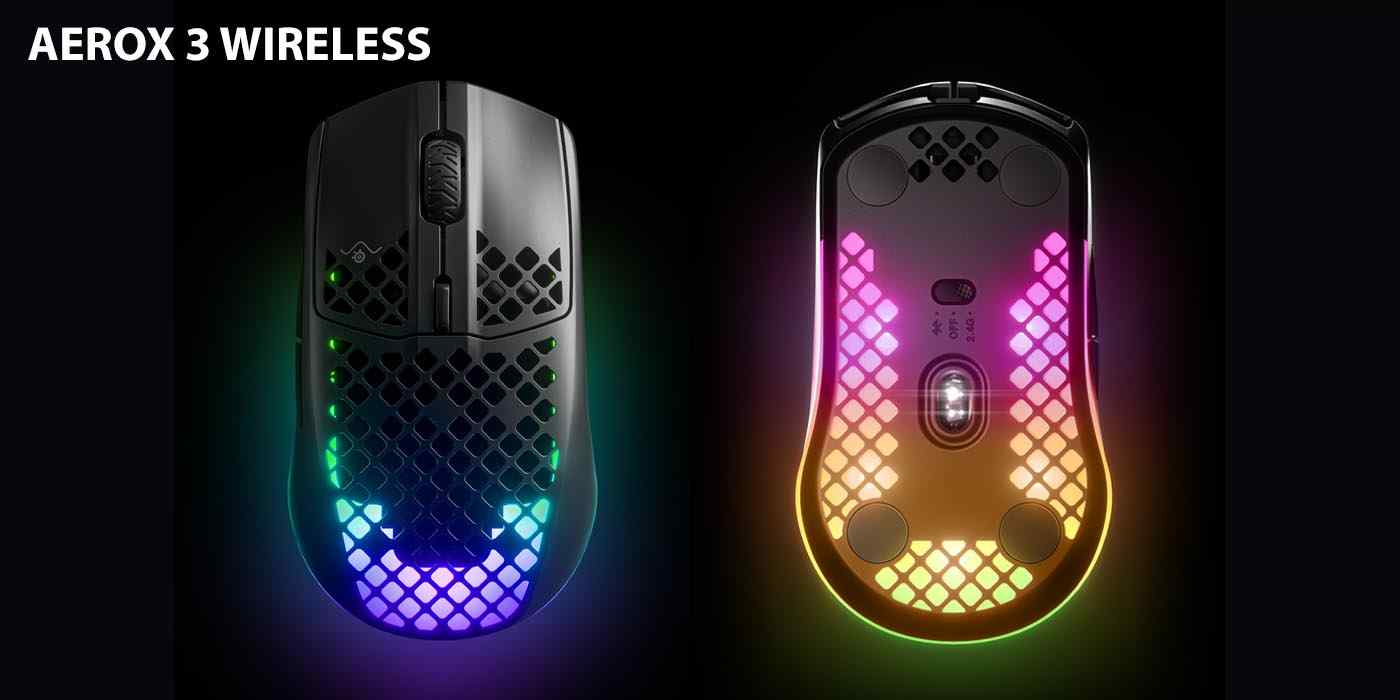SteelSeries Aerox 3 Wireless Gaming Mouse Review and Buying Guide
The SteelSeries Aerox 3 Wireless is the manufacturer’s lightest wireless mouse. It connects to 2.4 GHz or Bluetooth and has excellent autonomy. Its design is robust and its performance perfectly convincing. During the review of SteelSeries Aerox 3 Wireless Gaming Mouse, it offers excellent value for money for players wishing to enjoy a light and wireless mouse.
Finally! Slightly behind most of its direct competitors, SteelSeries finally unveils its first ultra-light gaming mice with the Aerox 3 and Aerox 3 Wireless models. With only 66 g on the scale, it is placed as an alternative to the flagship models of Razer and Logitech.
SteelSeries Aerox 3 Wireless Gaming Mouse Price and Availability
The two Aerox 3 Wireless gaming mice have an identical design and stand out mainly by the way they are connected. The first, offered at a price of 69.99 €, works wired but has a removable cable. The second, available at a price of 109.99 €, is based on a wireless connection compatible with 2.4 GHz and Bluetooth.
See on Amazon
The two mice have very similar designs and we will focus on this test mainly on the wireless version. It has 6 buttons, a new True Move Air optical sensor, and autonomy that can climb up to 200 hours according to SteelSeries.
SteelSeries Aerox 3 Wireless Gaming Mouse Review
Inside, the mouse comes with a USB-C to USB-A cable for charging or wired use, a USB-C dongle for the 2.4 GHz wireless connection, and an adapter allowing you to bring it closer to your mouse if your gaming PC is not too far away. A user manual completes the bundle.
With only 57 g on the scale, the SteelSeries Aerox 3 tackles the Glorious Model D, the Endgame Gear XM1, the Razer Viper, or even the most recent Roccat Burst Pro head-on. The Aerox 3 Wireless finds itself in competition with the excellent Logitech G Pro Wireless and Razer Viper Ultimate. More affordable than the latter, it should be able to position itself as an alternative of choice.
Design & Ergonomics
The SteelSeries Aerox 3 uses a frame and dimensions similar to those of the Rival 3 and Rival 3 Wireless mice. If you’ve ever had the chance to try these models, you shouldn’t be too out of place. The model retains a format that has already proven its worth in terms of comfort and handling, with an average size adapting to most players. Its dimensions are 120 x 67 x 38 mm for a total weight of 66 g.
Ultralight, wireless gaming mouse
For comparison, the Razer Viper Ultimate weighs 75g and the Logitech G Pro Wireless 80g and as of this writing, the Aerox 3 Wireless is positioned as the lightest wireless gaming mouse in the industry.
To achieve such a result, SteelSeries relies without much surprise on a perforated shell so as to glean a few grams on the scale. The palm rest, the upper part of the two main buttons as well as the base of the mouse thus have a diamond mesh. The side facades are spared, so as to maintain good comfort once the mouse is in your hands.
The mouse has a comfortable grip
We also directly review the general ergonomics of the mouse. As for the Rival 3, the shape naturally favors a grip in Claw Grip, with an ambidextrous format which has already been proven. It is also possible to enjoy good comfort in Finge Grip and you quickly feel confident overall once your hand is on this Aerox 3 Wireless. To give you some elements of comparison, here it is compared against its direct competitors, the Razer Viper Mini and the Logitech G Pro Wireless.
Despite this honeycomb structure and its featherweight, the mouse seems rather solid. By shaking it in all directions, no part presents any play and during normal use, no cracking is felt in the plastics.
By taking it with the full hand, no movement if you force on its side facades, but you will note on the other hand a slight sag if you press firmly on its base and the palm rest of the mouse. This has the effect of activating the DPI button, but again in conventional use no problem to point out.
The mouse also has an IP54 certification, a first in the world of gaming mice. This allows it to be able to resist any dust that may lodge inside its entrails, but above all to protect it against splashing. A good point for players who are not reassured by the presence of perforations on their mouse.
Mouse PCB is protected against dust and liquids
As for the buttons, no change compared to the Rival 3 Wireless that Edouard presented to you very recently. The mouse retains its 6 programmable buttons, with on the upper part the two main clicks and a dedicated button by default for DPI levels.
For the two main clicks, we find SteelSeries’ in-house mechanical switches, certified for 60 million activations. They are always so crisp and precise, with a tactile activation particularly pleasant to use. Nothing to say about that side.
Zoom on the buttons of the SteelSeries Aerox 3 Wireless
Between the two, the dial is also very convincing. The notches are well marked and adapt perfectly to use in-game. For a more classic scrolling in office automation, it is also relatively silent vis-a-vis certain competitors.
The last two buttons are positioned on the left facet of the Aerox 3 Wireless. A little too thin for our taste, they are still easy to access and offer a reactive activation but not as straightforward as that of the two main clicks.
The side buttons are a bit thin but still accessible
At the back of the mouse, there is a switch to switch between Bluetooth mode and 2.4 GHz mode. We will come back to this a little later. There are also 4 circular PTFE pads, which brings us to the main flaw of this SteelSeries Aerox 3 Wireless. Much too thin, they offer a very correct glide but let the base of the mouse rub against its mat at the slightest roughness or relief. It’s not complicated, after having tested more than a hundred mice, this is the first time that we notice this type of friction.
The SteelSeries Aerox 3 Wireless PTFE pads
By digging a little on the web (on Reddit or YouTube for example), it seems that we are not the only ones to have noted this phenomenon and unless SteelSeries decides to review its next copies, we will strongly recommend coming to install custom skates. In use, the glide remains very good and this friction does not necessarily have a huge impact on the performance of the mouse, but at nearly 110€ we obviously expect a glide without the slightest hitch.
On the front of the mouse, a USB Type-C connector allows you to charge the mouse or use it in wired mode. This is a mesh model a little softer than on the brand’s previous mice, but we are still a step below the best models in the sector, whether on the side of Razer, Xtrfy, or Roccat.
Wireless connectivity
The SteelSeries Aerox 3 Wireless works wirelessly and connects in 2.4 GHz via a USB Type-C dongle. A bold choice on the part of SteelSeries, not all gamers necessarily have a USB-C port on their motherboard or PC case. For these, the manufacturer obviously adds an adapter on which we will connect the USB-C dongle on one side and the USB-C to USB-A mouse cable on the other. Also, note that the mouse seems to work without any problem on an Android tablet via the USB-C dongle.
Unlike its competitors, the Logitech G Pro Wireless and Razer Viper Ultimate, the SteelSeries mouse also has the advantage of being able to connect wirelessly directly via Bluetooth. While this type of connection will not necessarily be used when gaming, it gives the Aerox 3 Wireless good versatility.
The mouse connects to 2.4 GHz or Bluetooth
On the autonomy side, SteelSeries announces up to 80 hours in 2.4 GHz mode and up to 200 hours in Bluetooth. It will obviously be necessary to take its data with a few tweezers, the values can change radically depending on the selected polling rate and the intensity of the RGB lighting.
SteelSeries Engine Features and Software
The mouse is compatible with SteelSeries Engine software. If you already have other devices from the brand, no need to download it and a simple update should do the trick to recognize the Aerox 3 Wireless.
From the tool, you can create different configuration profiles and assign them to your games or applications in order to load them automatically. We can thus opt for shortcuts or different lighting when playing CS: GO or when editing a video in Adobe Premiere.
SteelSeries Engine software
The “Parameters” tab is used to modify the assignment of the 6 mouse buttons as well as the up and down scrolling of the wheel. SteelSeries provides a list of basic actions and it is also possible to create and edit your own macros.
On the left of the screen, you can access the sensor parameters with the possibility of adjusting up to 5 sensitivity levels between 200 and 18,000 DPI with a step of 100 DPI. You can also adjust the level of attachment to the angles, the acceleration of the mouse, or the polling rate from 125 to 1000 Hz.
There are also some options for the mouse battery. It is possible to adjust an automatic standby time, to automatically deactivate the lighting when the mouse moves, or to activate the “High efficiency” mode in order to save battery. When selected, this mode automatically switches to a polling rate of 125 Hz and deactivates the lights.
Adjusting RGB lights
On the other hand, it is not possible to obtain a precise count of the number of hours remaining, but only visual indicators on the home page of the software.
The lighting precisely, they are configurable from a second tab. There are three zones on this SteelSeries Aerox 3 Wireless and it is possible to assign the effect or the color of your choice to each of them. The effects offered are quite basic, with fixed lighting, breathable, or a change of color among the gradients of your choice.
Performances
The mouse has a new SteelSeries True Move Air optical sensor. It is a derivative of the PixArt PMW3335 sensor, capable of handling speeds of 400 IPS and accelerations of 50G. It is also a low-power model, allowing wireless models like the Aerox 3 Wireless to have excellent battery life.
SteelSeries True Move Air Sensor
The sensor is capable of climbing up to 18,000 DPI, although this is of no interest. Most gamers will be content with a sensitivity typically between 400 and 3000 DPI. In use, nothing to complain about the reliability of the sensor. As on the vast majority of current models, the tracking is impeccable and responds perfectly to the slightest movements.
When gaming, the SteelSeries Aerox 3 Wireless has it all, except for this famous story of too thin skates. If we disregard this defect, the model clearly has something to come to overshadow its direct competitors from Razer or Logitech.
With its 66 g on the scale and its good comfort, the mouse is perfectly maneuverable and should be able to appeal to gamers with low sensitivity. The buttons are responsive, the wheel comfortable to use, and generally difficult to find much to complain about.
If you don’t necessarily need a wireless connection, the wired SteelSeries Aerox 3 may be a good alternative. The model uses a strictly identical format but is even lighter with only 57 g on the scale.
On the sensor side, we switch to a SteelSeries TrueMove Core model at 8500 DPI. It is capable of handling speeds of 300 FPS and accelerations of 35G, and again it should be able to adapt without any problem to 99.9% of the players.
Quite rare on a wired model, the Aerox 3 comes with a removable USB-C cable. This is also a rather soft and flexible mesh model, but not yet at the level of some competitors in the ultralight mouse sector.
Conclusion
Concluding the review of SteelSeries Aerox 3 Wireless gaming mouse, SteelSeries took its time to unveil its first ultra-light wireless model, but the result is more than convincing. By relying on the bases of the Rival 3, the manufacturer takes a base that has already proved its worth and transforms the test with featherweight and a wireless connection making it particularly handy and comfortable.
Faced with its direct competitors, we appreciate the presence of a dual Bluetooth / 2.4 GHz connection, its excellent autonomy, or its more than convincing overall performance. The only downside, these famous too thin pads can rub the base of the mouse depending on the surface of use.
For the rest, it’s hard to find much to review on this SteelSeries Aerox 3 Wireless Gaming Mouse. Offered at a price of 109 €, it is more affordable than the Viper Ultimate or the G Pro Wireless, while offering better versatility. It remains to be seen which will have the most suitable ergonomics for your hand, the three models showing excellent performance.
Follow Top and Trending on Google News and receive the latest alerts and the main news about apps, technology, beauty, entertainment, and all the top 10 related posts.



